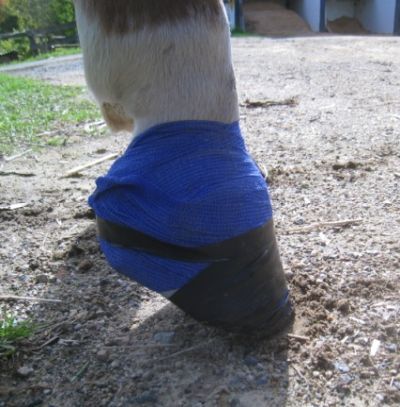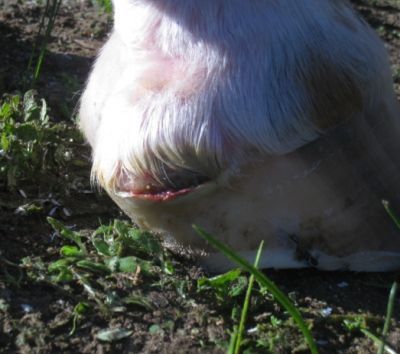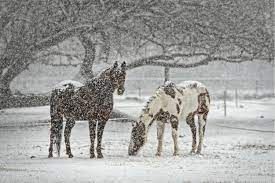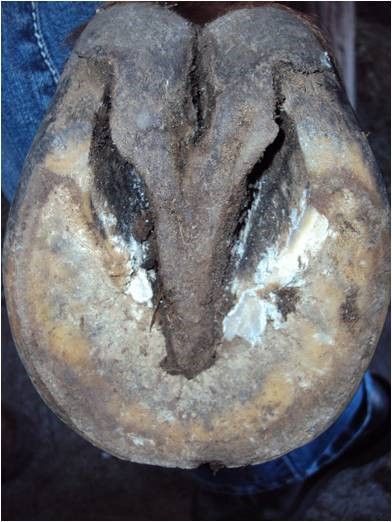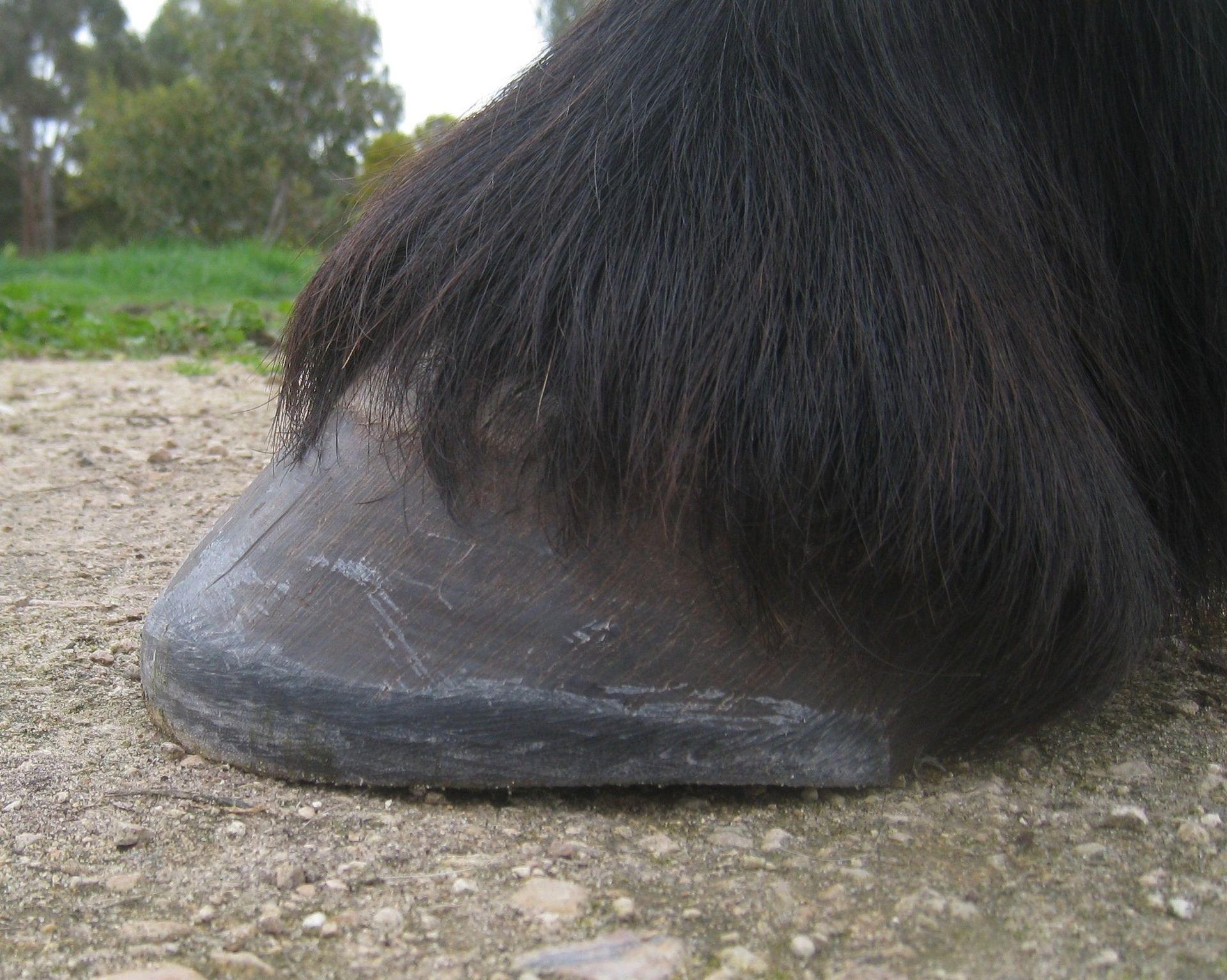Hoof Abscesses
Diagnosis, Cause and Treatment
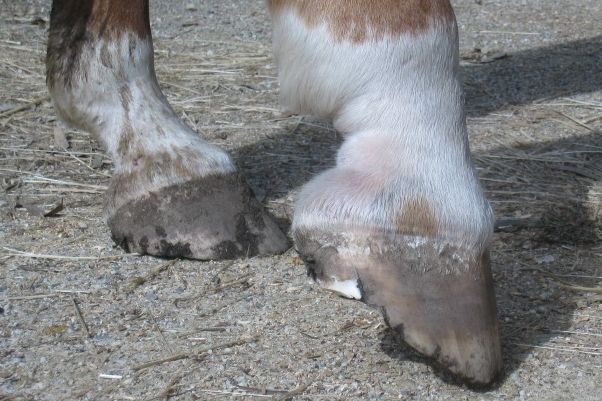
The horse in this photograph was suddenly non weight bearing on his off hind and I suspected an abscess. He is very lame, unable to bear weight, only the toe is touching the ground.
Unlike skin and other soft tissues, the hoof wall cannot expand to accommodate a buildup of fluid beneath the surface. So the accumulation of fluid causes pain. It also causes an area of separation between the sole or hoof wall and the pedal bone.
The increased pressure of pus collecting within the hoof capsule causes significant pain. The pus will take the path of least resistance to relieve the pressure and if left untreated, will usually work its way up the hoof wall, breaking out at the coronary band or the bulbs of the heel.
Diagnosis
An abscess close to bursting will present as quite sudden, severe lameness. The horse will barely be able to put any weight on the affected hoof. If you haven’t seen this before, it’s common to panic and think the horse has a broken leg! There may be some swelling and heat in the lower leg with the bigger abscesses. There is usually a warm area somewhere on the hoof. My advice is always to call the vet if you are really worried but once you’ve seen a few abscesses people will often treat it as one for a few days to a week and "see what happens". Some smaller infections inside the hoof can cause low grade lameness for many weeks without developing further. Any lameness that’s been going on for a couple of weeks or more should be investigated by a veterinarian.
Cause
Most commonly, an abscess is caused by bacteria entering the hoof via cracks, defects and holes in the white line (lamina layer) of the hoof.
They can also be caused by something sharp penetrating the sole and also by bruising. Often, if bruising is the cause, the tissue in the area dies off because of lack of blood flow and pressure. Once blood flow is restored, the dead tissue is carried by pus via the weakest exit point to the outside.
Abscessing can occur anywhere in the hoof. In my experience, they are most often seen as starting in a bar crack and exiting out the heel bulb.
Treatment
Occasionally I will find an abscess very close to the solar (ground) surface which can easily be helped along by opening it with my knife and relieving the pressure. Then we need to keep it draining for a few days, also keeping it clean and dry and treated with an antiseptic.
Usually however, there is nothing obvious from the outside. There is often a warm spot somewhere on the hoof. At this point I will use a poultice. I use a ready made poultice.They are dipped in water and then wrapped around the whole hoof making sure to include the heels and coronary band. The poultice encourages the abscess to exit the path of least resistance by softening the easiest areas usually the heel bulbs or coronary band. The poultice is then wrapped in cohesive bandage with a bit of duct tape around the toe area for durability.
After Bursting
You will know when the abscess has burst and the pressure relieved because the horse will be immediately less lame. There will be an area where there is a smelly discharge. At the heel bulbs this sometimes looks like a weepy graze. On the coronary band it looks like a horizontal split at the hairline. In the sole it will be a circular area and bloody. There is no mistaking that abscess smell! Usually the horse will be fully sound within a few days.
While waiting for an abscess to burst we follow these steps as well. We do not give "bute" for pain relief, we do not lock him up with food and water at his feet. We do leave him out with his companions as normal. The anti-inflammatory bute will slightly shrink the abscess and reduce the pressure in there. That doesn’t remove the infection but only serves to delay the rupturing of it. We want that pressure to build up to maximum so that it has nowhere to go but out. Movement also helps to burst the abscess. Standing around not using the limb will also delay the bursting.
When to call the VeterinarianIf you are concerned about your horses’ health please do not hesitate to call your Veterinarian.If the lameness hasn’t resolved in a week or two please refer to your Veterinarian. Anything more sinister will need to be ruled out (for example pedal bone infections). In my experience, abscesses can take anywhere from 24 hours to 3 months to burst but most will within a week.
Prevention
The main aim of abscess prevention is to prevent inflammation and separation of the lamina, therefore maintaining a tight white line connection which will keep the bugs out in the first place.A healthy, functional hoof will rarely abscess. The following measures will all help achieve that goal.
- Feed a diet low in starch (sugars)
- Feed a suitable mineral supplement
- Frequent correct trimming
- Thrust prevention
- Plenty of movement
These are big topics in themselves, but I am happy to discuss these with you personally until I write the respective articles!
Disclaimer
This article is based on my own training and experiences as a Natural Hoof Care Practitioner. Please follow my advice at your own risk! Always refer to a Veterinarian or do your own research if you have any doubts.

